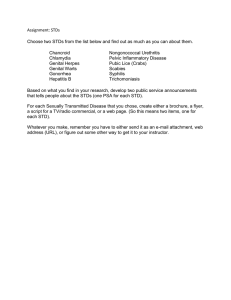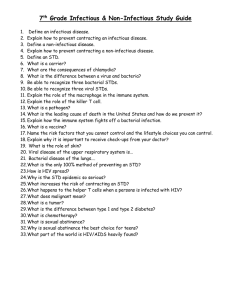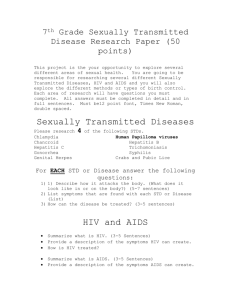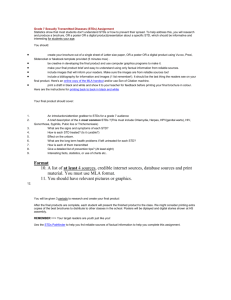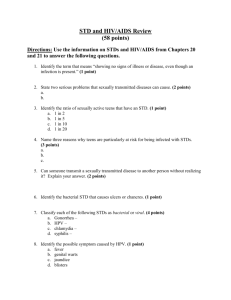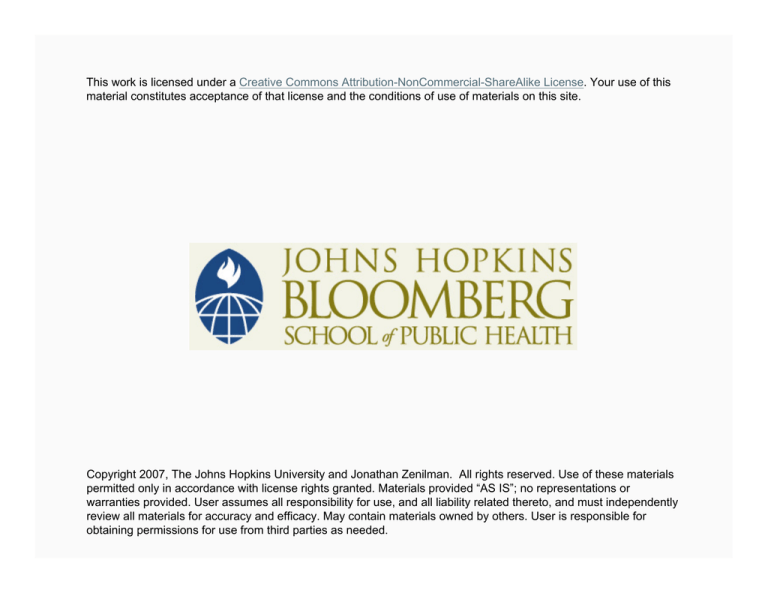
This work is licensed under a Creative Commons Attribution-NonCommercial-ShareAlike License. Your use of this
material constitutes acceptance of that license and the conditions of use of materials on this site.
Copyright 2007, The Johns Hopkins University and Jonathan Zenilman. All rights reserved. Use of these materials
permitted only in accordance with license rights granted. Materials provided “AS IS”; no representations or
warranties provided. User assumes all responsibility for use, and all liability related thereto, and must independently
review all materials for accuracy and efficacy. May contain materials owned by others. User is responsible for
obtaining permissions for use from third parties as needed.
Epidemiologic Basis of STD Control IV:
Program Services
Jonathan Zenilman
Johns Hopkins University
Section A
Interventions
Interventions—Personal
Selection of sexual partners
Recognition of high-risk situations
Condom/microbicide use
Symptom recognition
Seeking medical care
4
Interventions—Provider
Improve clinical practice
− Screening for STDs
− Appropriate treatment
− Liaison with disease control
Counseling skills
− STD prevention counseling
− Sexual health
5
Interventions—Structural
Advocacy
Providing health care infrastructure
Access to services
Providing social climate for STD discussion and
intervention
Confidentiality provisions
6
Four Successful Examples
Uganda ABC
Thailand 100% Condom
US Syphilis Elimination Project
Homosexual Men in the 1980s
7
Common Threads
High-level political support with multisectoral
response
Decentralized planning for behavioral interventions
using a multiplicity of methods (NGOs, POL, drama,
occupation-directed etc)
Interventions directed at women, youth and Avoiding
stigma
Involvement of religious groups in supportive roles
VCT
STI Control
Condom Promotion
Decreased multiple partnerships
8
US Syphilis Elimination Program
Grassroots involvement of community groups
Focused on African Americans
Rapid ethnographic assessments
Outreach screening efforts
Not targeting behavior change per se
>90% decrease in target group
9
Condom Use
10
RTA Intervention Components
Participatory development
Based on principles of social influence, diffusion and
“local structure”
Small group (squad) discussion and skills
development, formal education; integration into daily
routines; systematically presented
11
Structural HIV Interventions—Thailand
100% condom use campaigns
Regulation/cooperation
Economic development—impact on CSWs
Staggering of paydays
“Boredom reduction”
12
Sexual Behaviour, STDs and HIV
in 21-year-old men, northern Thailand, 1991–1995
60 Percent
Visited sex worker last year
50
Did not use condom on last visit
Lifetime history of STDs
HIV-positive
40
30
20
10
0
1991
1993
1995
Data Source: Nelson K, et al. Changes in Sexual Behavior and a Decline in HIV Infection among Young Men in Thailand.
New England Journal of Medicine, 1996; 335:297–303
13
Section B
Role of National STI Prevention Agencies
National Program Functions
STD surveillance
National diagnosis and treatment guidelines
Health policy and access
Regulation (dependent on country)
15
National Coordination
16
Integrated STD Control Strategies
Medical service
− High quality
− On-demand
− Quality assurance
− Well managed
− Screening services
− Provider training
Settings
− Identify settings where STDs are managed
− Provide outreach services for provider and patients
− Match treatment and management strategies to
setting and client environment
17
Settings Where STDs Are Managed
Primary health care providers
STD clinics
Family planning clinics
Antenatal clinics
Emergency departments
Military
Adolescent health
Travel clinics
18
HIV-Positives: Need for Intervention
Prevention interventions usually focused on the
uninfected—yet they become infected by HIV-positive
persons
Emphasis to date: case ascertainment
Majority of HIV-infected individuals continue high-risk
behaviors
Primary care and case management in a culturally
sensitive setting may have an impact
19
Provider Level Issues
Diagnosis and treatment
Implementation of practice guidelines
Provision of laboratory services
Quality assurance
Partner referral
20
State/Local Issues
Assurance
− Function: assuring adequate screening, diagnosis
and treatment services are available
Assessment
− Function: surveillance—including disease and
behavioral surveillance
Communication
− Increasing knowledge base for STD/HIV prevention
− Advocacy with policymakers
21
Skills Sets Required for Program Management: Technical
Clinical expertise
Laboratory
Quality assurance
Behavioral science
Communications
Demography
22
Skills Sets Required: Administrative
Personnel management
Budget/financial
Advocacy/political
Public relations/communication
23
Section C
Rational Program Development and Planning
Integrated STD Control Strategy
Settings
− Identify settings where STDs are managed
− Provide outreach services for provider and patients
− Match treatment and management strategies to
setting and client environment
25
Control and Surveillance Issues
High Level of Control Setting
Low rates of bacterial STDs
Importation via travel
HPV/HSV higher priority
Ascertainment of prevention programs
Increased genital HSV-1
Relapse prevention
26
U.S. Control and Surveillance Issues
Diverse population
High rates of STDs in minority and poor populations—
equal to those in developing countries
Fragmented health care system
Syphilis and chlamydia—high priority
Heterosexual HIV/STD epidemic risk
27
Issues for STD Controllers
Allocation of resources
− Clinical services
− Screening
− Public health outreach
− Surveillance
Objectives
− Preventing disease
− Preventing infection
28
Mantras
Expect the Unexpected
If everything is a priority-nothing is a priority-(Jack
Kirby 1988)
The most effective contraception is ambition (Belfast
MSSVD presenter 2001)
Anticipate and Respond to New Technology
Public Health Advocacy
Data Data Data
Be a Field Guy/Gal
29
Expect the Unexpected
Increases in STDs in Gay men
Rapid increases in QRNG-No therapy option
Rapid decreases and effectiveness of minoritytargeted syphilis elimination
Implications of HPV epidemiology
30
Anticipate
Behavioral response to new STD/HIV vaccine
Use political environment to develop clinical and
operational studies for “experiments of nature” – e.g.impact of service reductions, abstinence programs etc
31
Set Your Priorities
From a program standpoint-set a few priorities with
specific target goals
Keep a publicity chain regarding these priorities
Identify supportive media, and brief them on a regular
basis
Identify corporate/private sector partners
32
Show Me the Money!
STD interventions (in contrast to many other
interventions) are often supported by DATA
Use data to influence policymakers, payors
33
Quote
“Improved prevention of STDs should be an essential
component of a national strategy for preventing
sexually transmitted HIV infection.”
⎯The Hidden Epidemic: Confronting STDs, Institute of Medicine,
1996.
34

